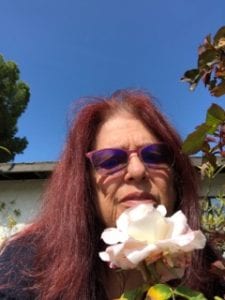Trina O’Quinn Takes a Tuneful Deep Dive, Reflects on How Boomers Have Impacted Music and Popular Culture
By Trina O’Quinn for the NABBW
 Recently during a water physical therapy session, I was walking my laps and the music of my youth began to play. I looked around the pool and noticed that the six of us in the class, all women, had begun to move to the rhythm of the songs. I realized that while our ages ranged from 20 to 70, we were all moving to the beat of the same music.
Recently during a water physical therapy session, I was walking my laps and the music of my youth began to play. I looked around the pool and noticed that the six of us in the class, all women, had begun to move to the rhythm of the songs. I realized that while our ages ranged from 20 to 70, we were all moving to the beat of the same music.
I started discussing the music with one of my pool companions. Slightly older than I, she recommended I watch the documentary Echo in the Canyon, a 2018 film which celebrates the popular music that came out of L.A.’s Laurel Canyon neighborhood in the mid-60s as folk music went electric.
After watching it, I reflected on how one generation of music influences the next. I decided to share my thoughts on how music evolved – even transformed – throughout our Baby Boomer women’s generation.
The questions that I considered were:
- How is it different and how is it the same?
- How were the Baby Boomers a bridge from the Greatest Generation to Generation X?

Instruments like this vintage bass guitar were not the instruments of the Big Band Era.
As I muse on the changes of music based on these questions, I write from the point of view of the girls of the Baby Boomer generation. We had an active impact on the culture and the this impact is what I most identify with. (As you read and enjoy this post, be sure to make time to check the many hyperlinks. They contain wonderful images, links to musical performances and a lot of great supplemental information.)
The Baby Boomer Generation Begins
The first wave of Baby Boomer births began in 1946. Setting the stage as the Baby Boomer years began are these major historical events:
- The start of the United Nations International Children’s Emergency Fund, now known as UNICEF
- The War Crimes Tribunal in Nuremberg
- The War Time Crime Trials held in Tokyo
- Mensa Organization founded
- AT&T introduces first car phones
- The scandalous bikini swimsuit is introduced in Paris, and
- The United Nations’ first meeting
Following the end of the War, people expected a better life than before. There were major job and housing shortages for those returning from the War, and, around the world, as couples married and had children, the baby boom began.
While we women were delighted the War was over, and pretended life was easy, the United States hadn’t yet reached the post-War economic prosperity. Rationing may have been over, but there were still shortages of food and material. This influenced the music.

Musical duo performs at a small nightclub.
In the 1946 timeline of music, adults were still listening to the big band sound. Perry Como had the #1 Hit “Prisoner of Love,” Jazz and Blues were still part of the Big Band sound with “girl” and “boy” singers.
Radio signals were returned to public broadcasting and 33-1/3 RPM (long playing) records were introduced.
Early Baby Boomer women enjoyed music that differed in both arrangement and sound from the Greatest Generation women’s music. While early Baby Boomer girls still focused on men soloists with back-up or orchestras, Boomer music was no longer solely recordings of live performances.
The younger musicians began working in recording studios and using smaller groups of musicians. Many times, the singers and musicians recorded at completely different sessions or locations.
Post-war teens chose to spend their extra money on albums, roll up the rugs, and dance at house parties. Because of this, big venues became less and less frequented. The hallmarks of the big band sound began to disappear.
American teenage girls began buying 45 RPM records, meaning that they could purchase single versions of the songs that they loved and heard on the radio. We bought the records and fell in love with the groups and individuals that preformed for our enjoyment. The boys listened to the same music because we did.
As 45s became more popular, they began to be introduced to rhythm and blues performers and the birth of rock and roll began to gestate. Black and white music influences began to blend.
The Second Wave of the Baby Boomers
In 1956, the second wave of Baby Boomers made their debut into the world. The major events of the times related to key technology and popular culture.
The major news stories included:
- The Suez crisis
- The Federal Aid Highway Act, implementing the construction of 41,000 miles of interstate highways
- Fidel Castro landing in Cuba at the start of the Cuban Revolution
- Rock and roll music sweeping the world, and
- Elvis Presley appearing on The Ed Sullivan Show and entering the US music charts for the first time with “Heart Break Hotel”

Female guitarist performing with musician playing harmonica in nightclub.
With all of this, the nation’s economy began growing. Along with economic prosperity the nation began looking toward the future with hope.
The two most important events of this era were the Federal-Aid Highway Act, which built the Interstate highway system, connecting the country via better roads and the expansion of the movie and television industry which brought personal televisions into our homes.
More people had access to the world and with televised entertainment now beaming right in our homes, those who could not afford a ticket to a play, movie, or live entertainment were no longer so isolated.
As the Federal-Aid Highway Act built the 0roads that allowed people to travel throughout the country by car, this offered additional exposure to the different sounds and cultures within our United States.
Likewise, movies and television connected families, even in the most rural parts of the USA, to what was happening in the rest of the country and the world at large.
Because of this, music changed. The Big Band sound was solidly transforming into Rock and Roll. The first wave of Baby Boomer women were now pre-adolescents. They were following the expectations of society but trying to rebel with their music. They idolized Elvis Presley and those performers who came after him. They were leaving the crooners of their parent’s generation, like Frank Sinatra, behind.
In a recording studio in Memphis Tennessee, four up and coming musicians, Elvis Presley, Johnny Cash, Jerry Lee Lewis, and Carl Perkins, came together for one informal jam session during December. This happenstance jam session ended up being one of the most important moments of rock and roll music. The attendees were inspired by rhythm and blues, country, and gospel, and when it was all mixed together, they made a sound that we would identify today as rock music.
These four upstarts later became known as “The Million Dollar Quartet.” This was one of the first times that front-billed musicians were all on one record together, and the concept of the rock band was formed. Singers started using their own musicians and collaborating and singing together.

Music was now created in studios, using tools like mixers and digital equalizers.
Music had now being recorded in studios owned by big record labels like A&R, Decca and EMI. The soloist was now isolated into a chamber his or her voice could be changed electronically. The backing musicians and their soloists were recorded separately then mixed later by sound engineers.
As music became less about one singer and a back-up band and more about the collaboration of artists, the subject matter and sounds of the music began to reflect the times.
The hopes, dreams, and fears of this growing generation became the central inspiration for their music while the Cold War progressed. Rock matured over the next ten years, as did those musical upstarts.
The Final Baby Boomer Wave
In 1966, the first wave of Baby Boomer women were turning 20, the middle wave of Boomer children were turning 10, and the last wave were turning two.
The major news stories included:
- The Miranda Rights/Miranda Warning becoming law
- The World’s first vertical Jump Jet, the Harrier, debuts
- The English Channel Hover-Craft service starts
- China’s Cultural Revolution began
- The Subway Strike in New York that brought the city to a stop
- Mini skirts are in fashion
- Charles Whitman, shooting from a tower, kills 14 and injures 31 in a killing spree at the University of Texas
- The U.S. has nearly 500,00 troops in Vietnam
- The Aberfan disaster occurs in South Wales, and
- The International Days of Protest against the Vietnam War, organized by Jerry Rubin and his Vietnam Day Committee at Berkeley, California happen. Student protests against the War happen all across the country
Chaos is an understatement.
In 1966, the prosperity that the United States once thought would last forever, turns to inflation. Due to the tensions of the Cold War, the tensions of the Vietnam War, and the tensions between Black and White America throughout the Civil Rights Movement, the country was deeply divided. And all of this news was televised.
Before the Viet Nam War, newscasts of war were not live. They were shown in the movie house once a month before the main feature or as part of a TV newscast weeks later.
For the first time, the world was watching the fighting while eating dinner. Young adults were witnessing what was happening to their friends and families.
The later Baby Boomer music transitioned from the band and orchestra sound to guitar, drums and sometimes piano or keyboard. All other strings and horns were eliminated. The result was the sound was different. We began to hear popular musicians sing out against the War.
Same twelve notes to choose from but a different sound was created. Most importantly, the music of 1966 reflected the division of the country.
The popular groups I listened to were: The Mamas and the Papas, The Beatles, The Monkees, Peter, Paul and Mary, The Beach Boys, The Rolling Stones, and Simon and Garfunkel.
Music sounds ranged from folk, the California sound, country, and rhythm and blues. When listening to the music these groups wrote and sang, you can hear the influence the early Baby Boomers had on the later Boomers.
Music Continues to Evolve
Popular music continued to transform, as the latest Baby Boomers, those born in 1964, became adults in the 80s.
The music of the 60s is a combination of hope, protest, nostalgia, and revolution. The 3 Days of Peace and Music promised by the 1969 Woodstock Music Festival in Bethel, New York, which began on August 15, is an iconic example of this.

Crowd enjoying a music festival.
The music of the 70s was about having fun, growing up, individualizing, gaining independence and changing the world.
The music of the 80s was about life in the fast lane, hope for the future, and girls gaining sexual freedom and more independence.
At that time, those who are nostalgic are listening to the music of their youth, those who are feeling revolutionary are listening to current popular music, and those who are protesting are listening to the new sounds of rap.
Musicians are always crossing over genres and continuing to influence each other. Their music is different and the same. They all have the same twelve notes to use while creating.
Music is what sets us apart while bringing us together.
- Baby Boomers took the Big Band Sound mixed it with gospel; country folk rhythm and blues then took away the horns and strings.
- Using guitars, drum kits and piano or keyboard they invented yet another different sound.
- The drummer became the conductor and rock and roll was born.
This gave Generation X a connection to the Greatest Generation and a jumping off place for their unique rock and roll sounds.
- Within our generation are women who brought change into the world.
- They did it in their homes and in the workplace, government, and society.
- Women had different needs and wants. Some embraced change in their entirety and others kept what they wanted and did not take on the changes that did not interest them.
- There were protests and movements from the traditional girls/women and the progressive girls/women.
- Ultimately, women in the Baby Boomer generation had the freedom of choice in how they expressed themselves and the ideals they wanted to uphold.
Our music reflects our generation’s individuality and similarity. As Jackson Brown says at the end of Echo in the Canyon, “Music happens in a particular time and changes everything.”
Trina O’Quinn is an actively licensed (California License # LMFT27407) Marriage and Family Therapist. Entering the profession as an older adult, Trina was in private practice for 30 years. During her career she was a lecturer at California University Dominguez Hills in the Marital and Family Therapy Program, where she supervised many students and mentored many associates.
Now retired, Trina keeps busy enjoying needle arts, reading, journaling and writing, as well as singing with a women’s chorus, peer networking, volunteering at a senior living center and reconnecting with old friends.


